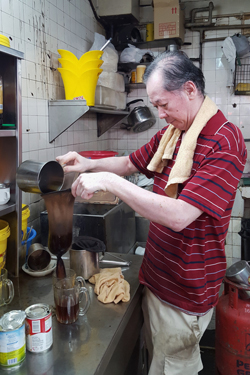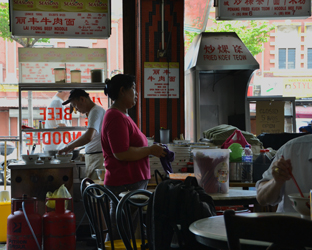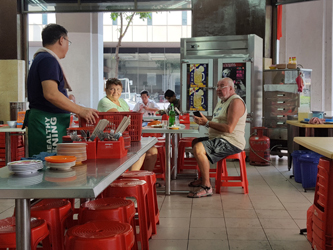Fieldwork in Malaysia
Coffeehouses, Authenticity and Change in Kuala Lumpur’s Chinatown


 Malaysia’s capital city of Kuala Lumpur has undergone tremendously rapid development over the last decades. Some of the changes being wrought upon the urban landscape are indexed in the evolution of its coffeehouses, where traditional kopitiams are gradually making way for newer, highly stylized coffee bars. In December 2016, I conducted a month’s worth of fieldwork in Chinatown, where these two coffeehouses are more clustered and starkly contrasted than elsewhere in the city. These photographs document kopitiams – Malaysia’s oldest surviving coffeehouses, and staple spaces of commensality and social gathering – at a time when they are fast dwindling in Chinatown, the historic heart of the city. Kopitiams, ever-enveloped in nostalgia, are on increasingly unsure footing in terms of survival and security, while new heritage-inspired cafes, co-opting kopitiam aesthetics, are mushrooming around them. My fieldwork involved semi-structured interviews with owners and consumers, as well as ethnographic observation of selected coffeehouses in the area, to explore some of the processes underpinning the shift from kopitiams to ‘heritage cafes’. The slow but sure demise of kopitiams coincides with larger patterns of gentrification and displacement in Kuala Lumpur, and these photographs form a partial visual record of them at this crucial point in time, amid the changing contours of a developing city.
Malaysia’s capital city of Kuala Lumpur has undergone tremendously rapid development over the last decades. Some of the changes being wrought upon the urban landscape are indexed in the evolution of its coffeehouses, where traditional kopitiams are gradually making way for newer, highly stylized coffee bars. In December 2016, I conducted a month’s worth of fieldwork in Chinatown, where these two coffeehouses are more clustered and starkly contrasted than elsewhere in the city. These photographs document kopitiams – Malaysia’s oldest surviving coffeehouses, and staple spaces of commensality and social gathering – at a time when they are fast dwindling in Chinatown, the historic heart of the city. Kopitiams, ever-enveloped in nostalgia, are on increasingly unsure footing in terms of survival and security, while new heritage-inspired cafes, co-opting kopitiam aesthetics, are mushrooming around them. My fieldwork involved semi-structured interviews with owners and consumers, as well as ethnographic observation of selected coffeehouses in the area, to explore some of the processes underpinning the shift from kopitiams to ‘heritage cafes’. The slow but sure demise of kopitiams coincides with larger patterns of gentrification and displacement in Kuala Lumpur, and these photographs form a partial visual record of them at this crucial point in time, amid the changing contours of a developing city.
From top right:
Ting, aged 65 years, strains coffee through a sieve in the back kitchen of a kopitiam. He has been making traditional kopi for over two decades now, having learned the skill from his father before him. Kopi in Malaysia is typically darkly roasted with butter or margarine, and, as with the cup Ting is preparing, served with condensed milk and sugar syrup. The craft of kopi-making is slowly dying, as younger generations of kopitiam-owning families continue into tertiary education and the skill is not passed on as before. Many kopitiam owners take pride in telling how they retain old-timers like Ting for their skill in the kitchen, reluctant to delegate the task to the migrant workers that staff the rest of the shop. In this way the figure of Ting preparing drinks is a safeguard of a certain kopitiam authenticity and sensibility, one intimately tied up with ideals of national identity, continuity, craftsmanship, and nostalgia.
Thomas prepares a bowl of beef noodles in his kopitiam, one of the oldest and most successful in Chinatown. The shop has been family-owned since it began to operate in the 1950s, and he remembers helping his father out in the shop as a child, after primary school. He attributes the shop’s continuing success to the famous, handmade beef noodles they serve, but bemoans the lack of interest in kopitiams among local youth, and says the future of the business is uncertain. Thomas took the helm in his late teenage years, but is unsure if any of his own children will take over after him. Given that the shoplot they occupy is prime real estate in the heart of Chinatown, and rental rates rise every three years, the kopitiam seems an anachronism in modern-day Kuala Lumpur, and its survival is noteworthy.
Mr Tay, on the left, interacts with a British tourist couple in his kopitiam. He and his wife were forced to relocate from their previous lot just up the street, where they had operated for 15 years, due to rising rental rates – a narrative of displacement that presented itself again and again during fieldwork in a rapidly gentrifying Chinatown. The new address is considerably less busy but sits directly opposite two popular backpacker hostels, and I observed many a tourist curiously lingering around the fringes of the kopitiam, peering in hesitantly at what must have seemed a chaotic and unfamiliar restaurant atmosphere. This couple came in, ordered steamed pau buns and drinks, and were negotiating payment and directions to their next destination with Mr Tay. I found their expressions – one of confusion, the other of bemusement – an apt indexing of how it must feel to navigate the codes and lingo of the unfamiliar kopitiam space.
